






 |
 |
 |
 |
 |
 |
 |
Laufhunde - Meutehunde - Bracken > Menü Jagd & Jäger |
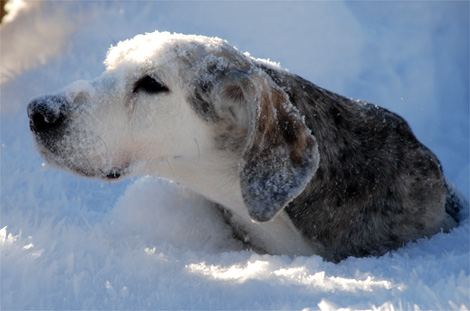 |
Hare hunting with the Dunker in Norway To better understand the Dunker's working methods it's useful to first have a look at the natural conditions and hunting traditions in its country of origin. Norway, whose northern half lies above the polar circle, is covered for about one quarter of its surface by forests and is defined by an extremely long coast-line, the high mountain ranges of the inland, the moors and sparse fjell landscapes, the hills and fields in the south. So, climate and vegetation are very different according to region: in the heartland spruce and pine forests dominate, in the south deciduous woodland, while in the mountains and in the north of the country birch forests characterize the natural scenery. The southern and south-western costal area is relatively mild and sees much less snow, in central Norway and the eastern inland instead winter temperatures go down to minus 30 degrees Centigrade and in the far colder north you have to add the fact that during the winter months it stays rather dark even at day-time. |
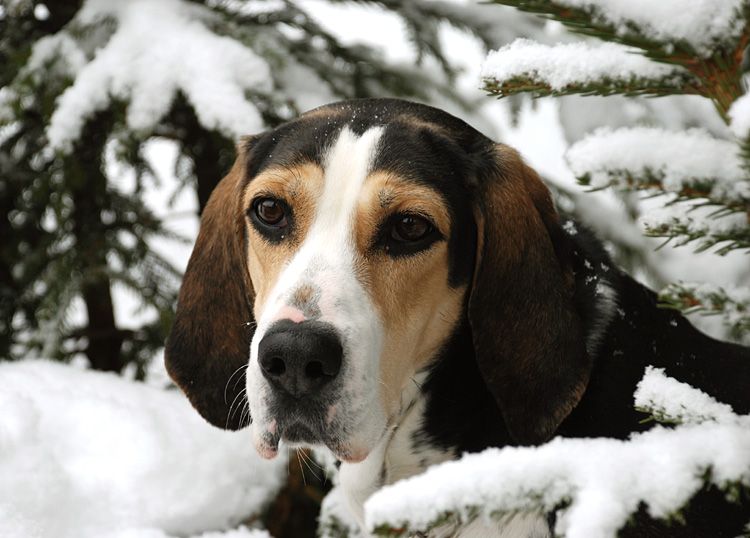 |
As mentioned in the breed portrait, hare hunting has a tradition in Norway that goes back for centuries. In the south they always used special hare hounds, while in the north these breeds, originally, were not common, since with a relatively strong hare population there was no need for dogs with particular skills, unlike in the southern parts of the country. Therefore it has only been for about the last 10 years that sportsmen up north have discovered the fascination of working with hare-hounds. Generally speaking though, the hare hunt which was still widespread throughout most of the 20 th century has begun to increasingly loose its appeal in the nineties. In 2009 the Norwegian Hare-hound Federation counted only 3300 members with an estimated total of 4-5000 hare hunters nationwide. So it comes as no great surprise that while sportsmen in the past went out hunting in groups, nowadays the houndsman will go off alone or just with a friend or two. The hare feeds and travels around mostly at night and lies in his hide-out during the day. The hare-hound, no matter where in Europe he is working, must explore the pasture, find the night trail and follow it to his quarry's den. Usually the hunter will leave his Dunker 10-30 minutes time to search for the trail, while he might either slowly follow the hound or just sit down and wait. In case the Dunker realises that there is no hare scent in a certain area, he will simply return to his master after a while, and they can move on to another part of the terrain. |
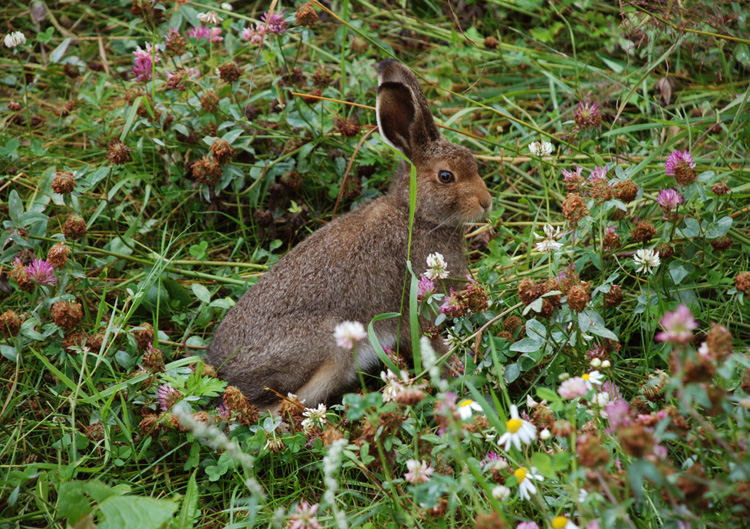 |
Perhaps at this point it should be explained that the term hare in Norway automatically means snow hare as the field hare is so rare in the country that it's practically inexistent. But as the two types have rather different behaviour patterns, - the field hare for instance might move almost straight ahead for several kilometres whereas the snow hare moves to and fro in the same area - unexperienced Dunkers may well have problems when, abroad, they are set to hunt or perform working trials on field hare trails. The only way to avoid this inconvenience is to help already the very young hound to get used to this unfamiliar quarry. Snow hares, during their long meal, move quite a lot; they hop to a certain spot, eat, hobble along a bit further, stop again to pasture some more, hop further to the next place and so it goes on and on. Clearly, for the hound this habit creates a rather tricky scent puzzle, especially as among all these trails he has to find the one leading off the pasture, back into to wood. To succeed in his task without wasting time, the Dunker will search the feeding ground circularly, or to be more precise, in ever growing circles, until he hits the scent left by the hare when leaving a certain spot to continue his meal elsewhere nearby and to finally return to his den. Though there are a few Dunkers who lack this genetically determined behaviour and follow the track step by step, huntsmen appreciate and prefer those who search out in circles, because they usually find the hare very fast compared to those who follow each step of the hare’s night trail. This so called night trail the hound will follow silently up to the hiding place and only now the Loud Chase begins. Many Dunkers give a little cry of joy and excitement when they see the hare jumping up in front of them; in Norwegian this sound has a specific term, namely “beskrik”. From this point on the Dunker's job is to keep his quarry on the move and his master accurately informed about their progress by continuously giving voice. Meantime the hunter must determine the best spot where to await the passing hare, which is not as easy as it may seem, because he has, indeed, to be very familiar with the ground, has to be able to read it properly and, naturally, interprete his hound's voice correctly. The Dunker will bark with different sounds and frequencies according to how far he is still away from his game. Often his voice gets clearer and more intense when he perceives the hare quite near and less intense when he gets too far behind again. Some Dunkers in their first 4 years of life remain perfectly silent when the hare is more than 10 minutes ahead of them, but with age these hounds might get to give at least some voice on the occasion. |
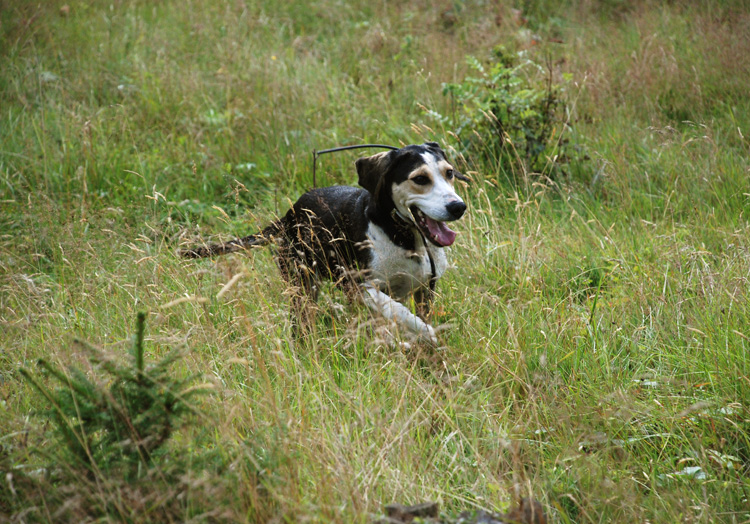 |
Clearly, the master must know by the sound of his hound when he can expect the hare to arrive at his post. Normally the quarry has a lead of between 1 and 5 minutes over his pursuer and part of the proper positioning of the hunter depends on the territory and, of course, the hare, who might give a very long and wide-ranging flight or a rather short one. According to air and ground temperatures, humidity, wind and so one, the Dunker may also loose the tricky hare's trail twice or thrice and will need some time to recover it, but he will normally not change over to a new, different trail. One of the main reasons why working trials in Norway request a Loud Chase of a total of 120 minutes for 1. prize is precisely to give the hound a chance to show that he has what it takes for a proper hunt: strong hunting instinct, stamina, will power and capacity to recover the lost trail. As the Dunker works silently while trying to recover a trail, his actual “time of duty” is far over 2 hours. In fact, a hare-hound who chases his quarry aloud for 120 minutes in a total of 180 minutes hunting time is considered of very high quality. By the way, during working trials a loss of trail for no more than 5 minutes isn't counted as such. Only if the Dunker passes this limit the stopwatch is halted and not switched on again before he hasn't picked up the trail and his loud chase. If the hound recovers the hare after more than 90 minutes, it will be considered a new game and a new “los”. The requirements during a working trial are the same for all hare-hounds in Norway and 11 different skills are judged on a scale from 1 – 5. Example: for voice during working on the night trail 5 is excellent (silent on the night trail), 4 very good (very little voice), 3 good, 2 sufficient, 1 bad, and the letter G for unacceptable. It’s unacceptable if they sound as if they had found the hare, and the hare is on the move when they work the night trail. Depending on how much voice they give, the points they receive will drop from 5 to 4, 3, 2, 1, G. The different skills required are: 1) Hunting instinct (the most important) (points x 3). 2) How the hound works together with his master and searches the area (p x 1). 3) How the hound works from the moment he has found the trace until the hare leaves his hiding place and starts to run; effectiveness (p x 2). 4) Voice on the night trail (p x 1). 5) Voice when he has lost the track (p x 2). 6) How he works during the chase (los) (p x 2). 7) How he works when he has lost the track; effectiveness (p x 2). 8) The frequency of the voice during the chase depending on the distance to the hare (p x 1). 9) How well you can hear the voice (p x 2). 10) Physical condition of the hound (p x 1). 11) Obedience (p x 1). These points are added to the “los” time. |
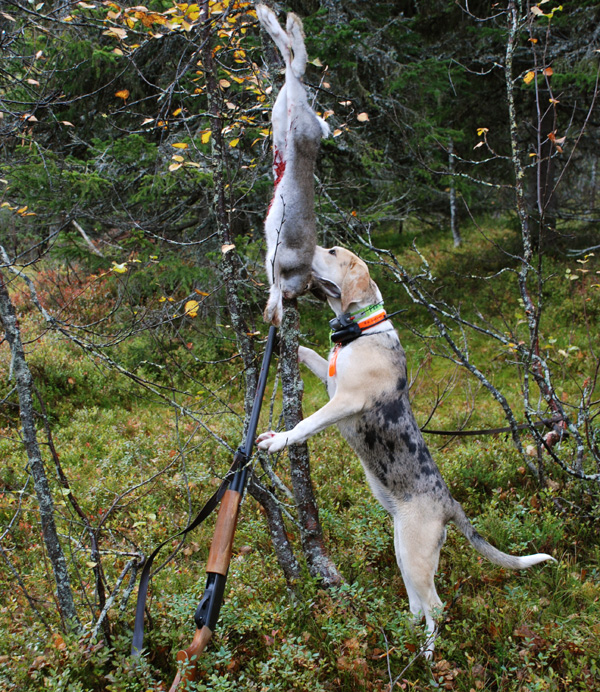 |
Now, who believes that it's an extreme pressure for the hare to be pursued so long and insistently by the Dunker should rethink, because generally it's the hare who controls the hound, and if the former realises that the hound is 5-10 minutes behind he may easily take a break to feed peacefully along the way! In some parts of Norway the hare population is so low that the Dunker is expected to try for at least 90 minutes to re-find a lost scent instead of searching, unpromisingly, for a new one. As is well-known the hare is a master when it comes to outsmart and confuse the hound. Often he retraces so far on his own trail that he almost meets with his pursuer, but at the last moment takes a leap 90 degrees off the track. To flight along dusty roads that can't keep the scent for long is another of his tricks to shake off the hound. But, of course, the Dunker learns by experience, too. As soon as he realises the loss of the trail he will systematically examine the surrounding area in ever wider circles, just like he did on the pasture, to find the scent once more. If this doesn't work he, too, will follow the hare's trail backwards and search widely on both sides for the point where his quarry jumped off. Usually these methods get him back on the track in an acceptable time. |
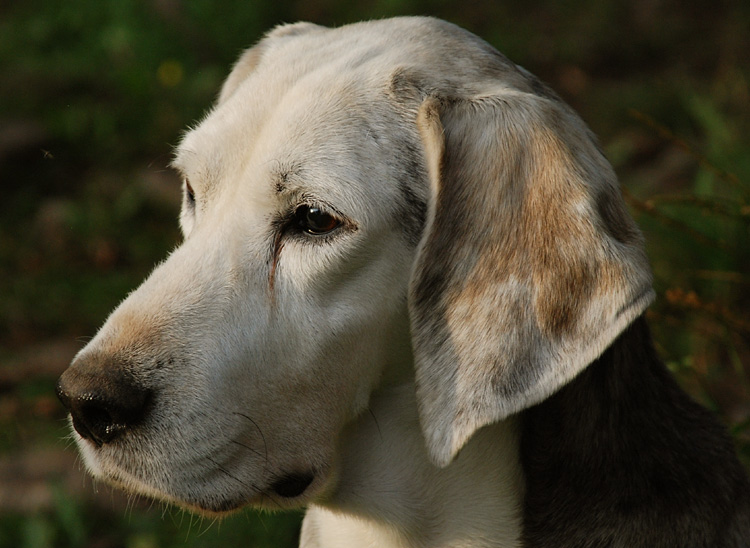 |
Supposed the master has followed the movements of hound and hare attentively and chosen his post well, the chase will end with a successful shoot, and, naturally, the young hound in particular shall get the satisfaction of sniffing amply at his prey. Depending on how long the first hunt lasted, the master might as well bring his Dunker, after a little break, to another area and send him off for a new search. Thanks to the GPS it's easy to determine that a Dunker on an average 5-6 hours hunting day will run 30-35 km; some hounds have an even longer range of 40 – 50 km, and a few do less (20 – 25km), but it seems quite obvious that thanks to his passion and stamina this hound has no problem to work for hours on end and surely hare-hunting will never get boring for him...! |
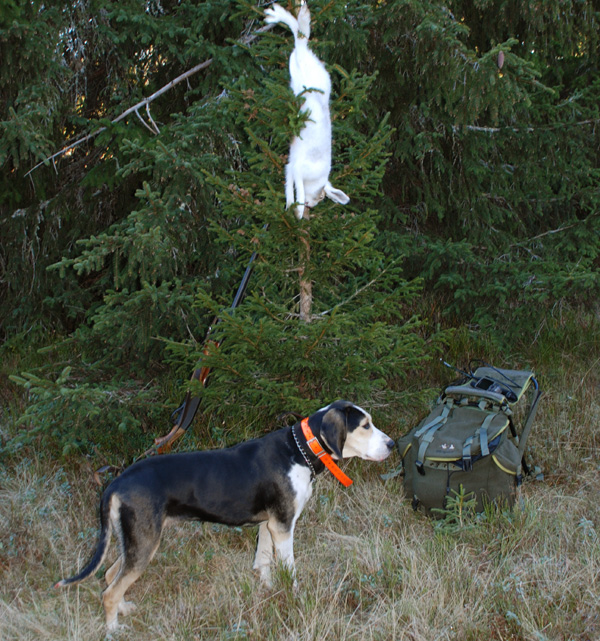 |
Dictionary for some special Norwegian hare-hunt words and expressions: Utslag: When the dog starts the search for the trace of a hare in an area. We prefer that he does this independently for 10 – 30 minutes. Fot: When the dog has found a trace from last night, follows it and tries to find the spot where the hare is sitting/hiding. Uttak: When the dog has found the spot/hiding place where the hare is sitting, and the hare now leaves his hiding place to avoid the dog. Beskrik: If the dog sees the hare leaving his hiding place, it often “yells out”, eager to follow it. These first barks we call “beskrik”. Los: When the dog has found the hare, the game takes flight, and the dog chases it giving voice (The symphony for us enthusiasts). Nyansering: The dog uses different tones and frequencies when he gives voice, depending on how far he is behind the hare. By "reading" the voice you can tell when to expect the game to appear. The barking is often more intense, and the tones are brighter when the dog is close behind, and less intense when he ’s further behind. The hare is often between 1 – 5 minutes ahead of the dog. A Dunker, when he ’s young (1 – 4 years), is often completely silent when he comes more than 10 minutes behind the game, but might eventually give some voice when he gets older. Aus: The frequency of the barking (in the “los”), when the dog follows the game. Tap: When the dog has lost the track of the game, and tries to find it again. Post: Where the hunter waits for the game to appear. The hunter has to read the terrain, and pick a spot where he/she believes that the hare will pass. Ture(r): The way the hare moves around in an area during the los. It doesn’t move in circles, but crosses in different directions in an area. Some cross points can be excellent posts. |
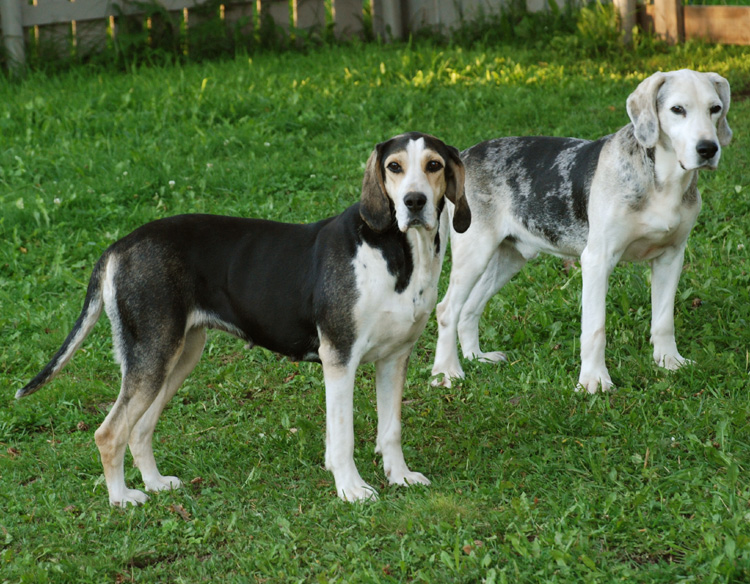 |
All photos: Per Harald Sivesind (Norway) |
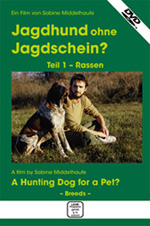 |
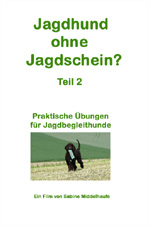 |
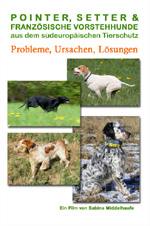 |
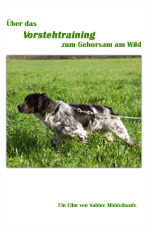 |
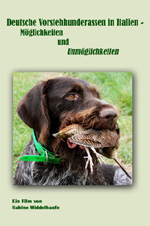 |
| home | Seitenanfang | Menü Fotoalbum |